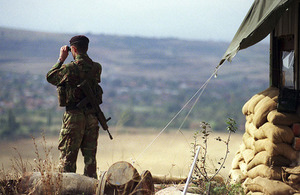
The NATO-led KFOR peacekeeping force first entered Kosovo in 1999
The Minister yesterday spoke at a National Army Museum event to mark 20 years since a NATO-led peacekeeping force arrived in Kosovo to help end the conflict.
The UK was a key contributor to the UN-mandated force, known as KFOR, which entered Kosovo to bring peace and stability following the conflict of the 1990s.
Two decades on, the UK's commitment to security in the region remains steadfast and the Armed Forces Minister yesterday evening announced at The National Army Museum that the UK will continue its contribution to the NATO KFOR mission.
Mr Lancaster himself was a serving soldier in the operation as a member of the Royal Engineers.
Minister for the Armed Forces Mark Lancaster said:
I can still remember the warm welcome I received from the local population when serving in Kosovo two decades ago as a Royal Engineer.
Those friendships have not been forgotten by either country and so we will be extending our decades-long commitment to securing the long-term stability of the region.
The Minister also announced that the UK would be continuing its support to the EUFOR mission in Bosnia and Herzegovina as part of its commitment to supporting stability and security in the Western Balkans.
Since their deployment, UK troops have enhanced KFOR's Intelligence, Surveillance and Reconnaissance capability, significantly increasing its situational awareness. KFOR began as a peacekeeping force in the late 1990s and now acts as one of the main security providers in Kosovo. Troops are contributed by some 30 nations including, Italy, Turkey, Poland and the US, as well as the UK.






